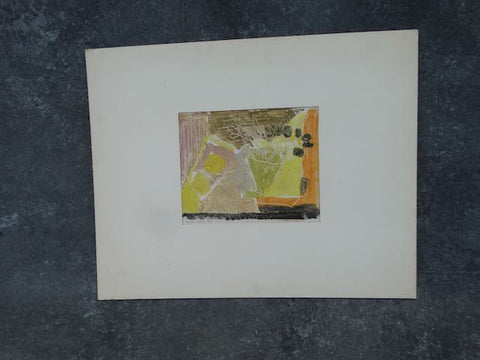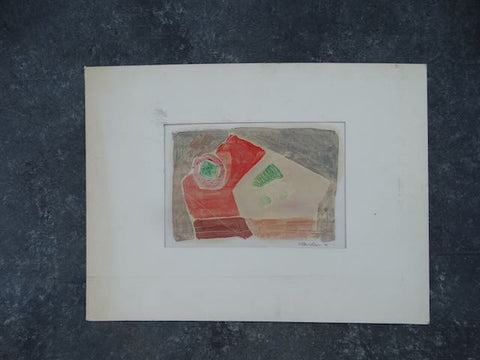David McCosh
David McCosh - November - Oil on Canvas 1939 P2964
Regular price
$4,500.00
This terrific abstract by the distinguished Northwest artist was shown at the Walker Gallery in New York (label is pictured in the photos).
Art measures 20" x 24". Frame is 21 1/4" x 25 1/2".
A Cedar Rapids, Iowa native, David McCosh followed his art interests with studies at Coe College (1922-23) and the Art Institute of Chicago (1923-26). He received a full fellowship for graduate studies (1927-29) and won the Institute's prestigious John Quincy Adams scholarship in an annual competition with his painting Prodigal Son. After relocating to New York City, he joined the Art Students League and spent time in 1928 studying art in Europe.
McCosh and Edward Rowan were long-term acquaintances; David was kept informed of happenings in the Cedar Rapids art community, including the Little Gallery and Grant Wood's commercial success. He became a painter in Oyster Bay, Long Island, NY for the Louis Comfort Tiffany Foundation with the aid of a Tiffany fellowship (1930-31). McCosh also served as an instructor at the Davenport School of Art (Davenport, IA) and as the director of the Davenport Municipal Gallery, Iowa's first city art facility, now known as the Figge Art Museum.
Following a European trip, McCosh was asked to be an instructor at the 1932 Stone City Art Colony and accepted the position. That summer, the artist had a one-man show at Art Institute of Chicago (AIC). McCosh returned for the 1933 colony and may have briefly left the grounds for artistic reasons. He disliked the local crowds that came on weekends and grew frustrated over students copying Grant Wood's style, producing "little Woods," as he called them.
A master of lithography, McCosh joined the faculty of Chicago's Art Institute, where he taught the medium. While in Chicago, he was a judge for Iowa Artists Club competitions and was hired as a WPA artist to paint a mural for the CCC (Civilian Conservation Corps) camp in Willow Springs, Illinois. In 1934, McCosh turned over all of his Art Institute classes to Francis Chapin, another Stone City faculty member, and accepted an art faculty position with the University of Oregon. That same year, he also married the artist Anne Kutka, and the couple would make their home in Eugene.
The 1930s-1940s are considered McCosh's most productive period. During this time, he completed a WPA mural commission for the Kelso, Washington post office (Incidents in the Lives of Lewis and Clark) with its installation in 1938. Two huge murals (Themes of National Parks) were done for the federal Department of the Interior building in Washington, D.C. (1941) and he regularly exhibited at the Walker Gallery in New York City. In 1942, he painted and installed a WPA mural for the Beresford, South Dakota post office, even while maintaining a full teaching load in painting and lithography.
Known as a teacher who inspired a northwestern generation of painters, McCosh continued to paint murals and took an extended sabbatical from 1949-50. While living in Mexico and New Mexico, he experienced a second rebirth of his work from uninterrupted painting. In 1954, he was made a full professor at the University of Oregon and retired as a professor emeritus in 1970.
McCosh was exhibited widely, including the following galleries: his first one-man show at the Little Gallery, Cedar Rapids (1927-29); the Art Institute of Chicago (1929, 1932); International Water Color Show, Chicago (1929); Whitney Museum (1933); Walker Gallery, NYC (1934-41); Seattle Art Museum (1937); the New York World's Fair (1939); Golden Gate Exhibition, San Francisco (1940); the Portland (OR) Art Museum (1946), and the University of Oregon, Eugene (1947-77, various years). He died in Eugene, Oregon in 1981.
Source:
"David McCosh": The Stone City Art Colony and School 1932-1933, http://projects.mtmercy.edu/stonecity/artists/mccosh.html (Accessed 02/06/2013)
McCosh and Edward Rowan were long-term acquaintances; David was kept informed of happenings in the Cedar Rapids art community, including the Little Gallery and Grant Wood's commercial success. He became a painter in Oyster Bay, Long Island, NY for the Louis Comfort Tiffany Foundation with the aid of a Tiffany fellowship (1930-31). McCosh also served as an instructor at the Davenport School of Art (Davenport, IA) and as the director of the Davenport Municipal Gallery, Iowa's first city art facility, now known as the Figge Art Museum.
Following a European trip, McCosh was asked to be an instructor at the 1932 Stone City Art Colony and accepted the position. That summer, the artist had a one-man show at Art Institute of Chicago (AIC). McCosh returned for the 1933 colony and may have briefly left the grounds for artistic reasons. He disliked the local crowds that came on weekends and grew frustrated over students copying Grant Wood's style, producing "little Woods," as he called them.
A master of lithography, McCosh joined the faculty of Chicago's Art Institute, where he taught the medium. While in Chicago, he was a judge for Iowa Artists Club competitions and was hired as a WPA artist to paint a mural for the CCC (Civilian Conservation Corps) camp in Willow Springs, Illinois. In 1934, McCosh turned over all of his Art Institute classes to Francis Chapin, another Stone City faculty member, and accepted an art faculty position with the University of Oregon. That same year, he also married the artist Anne Kutka, and the couple would make their home in Eugene.
The 1930s-1940s are considered McCosh's most productive period. During this time, he completed a WPA mural commission for the Kelso, Washington post office (Incidents in the Lives of Lewis and Clark) with its installation in 1938. Two huge murals (Themes of National Parks) were done for the federal Department of the Interior building in Washington, D.C. (1941) and he regularly exhibited at the Walker Gallery in New York City. In 1942, he painted and installed a WPA mural for the Beresford, South Dakota post office, even while maintaining a full teaching load in painting and lithography.
Known as a teacher who inspired a northwestern generation of painters, McCosh continued to paint murals and took an extended sabbatical from 1949-50. While living in Mexico and New Mexico, he experienced a second rebirth of his work from uninterrupted painting. In 1954, he was made a full professor at the University of Oregon and retired as a professor emeritus in 1970.
McCosh was exhibited widely, including the following galleries: his first one-man show at the Little Gallery, Cedar Rapids (1927-29); the Art Institute of Chicago (1929, 1932); International Water Color Show, Chicago (1929); Whitney Museum (1933); Walker Gallery, NYC (1934-41); Seattle Art Museum (1937); the New York World's Fair (1939); Golden Gate Exhibition, San Francisco (1940); the Portland (OR) Art Museum (1946), and the University of Oregon, Eugene (1947-77, various years). He died in Eugene, Oregon in 1981.
Source:
"David McCosh": The Stone City Art Colony and School 1932-1933, http://projects.mtmercy.edu/stonecity/artists/mccosh.html (Accessed 02/06/2013)














